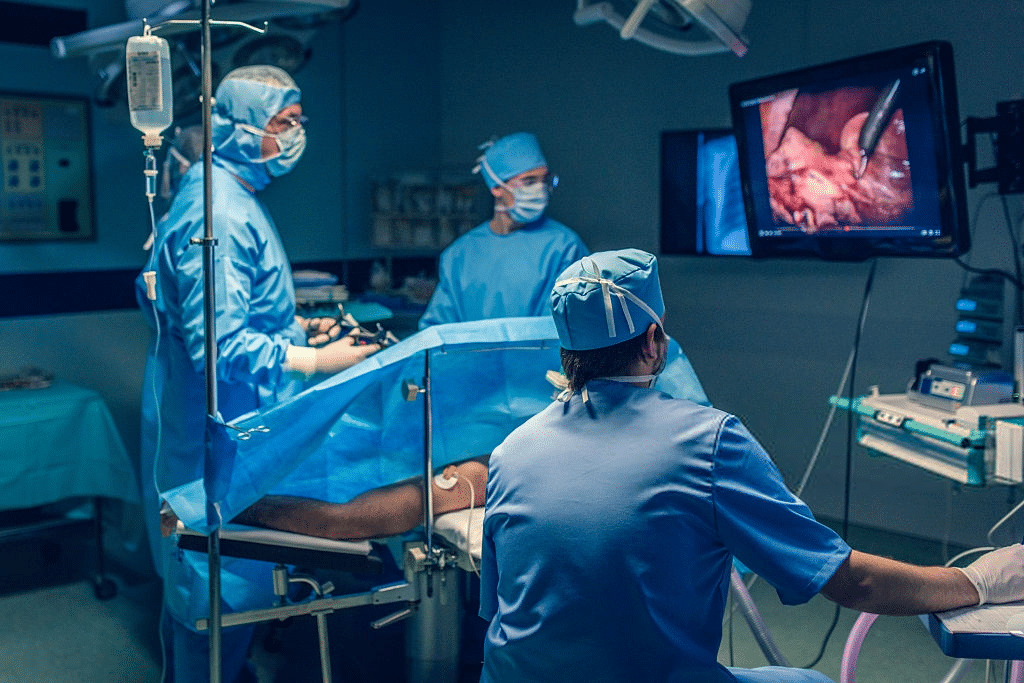Diagnostic laparoscopy, or simply known as laparoscopy, is a surgical technique that allows access into the organs situated in the abdomen region.
Laparoscopy consists of a small camera that helps to capture a view inside the abdominal organs. The instrument used to perform laparoscopy is the Laparoscope. It is a slender tool with a high-resolution camera and provision to impart high-intensity light. This narrow tube is inserted into the target organ through a small incision made in the abdominal wall. The images captured by the camera are then displayed on a monitor.
Laparoscopy is a keyhole procedure that lets the doctor get a clear view inside the abdomen, without having to perform open surgery. This procedure even used to collect biopsy samples.
Therefore, it is a less invasive procedure that ensures a speedy recovery, high success rate and less painful.
1.Why is Laparoscopic surgery performed?

The abdomen is prone to a large number of complications such as pelvic/abdominal pain, internal bleeding, and pregnancy-related issues. Laparoscopic procedure aids in investigating the anomalies within the abdomen and further determining the treatment.
Diagnostic Laparoscopy is often performed on cases of liver disease, ascites, abnormal abdominal growth, internal bleeding, and cancer staging.
For diagnosis of problems associated with the abdomen, other imaging techniques such as ultrasound, MRI and CT scan are used. However, when these examination tools do not reveal enough information, Laparoscopy is the most reliable procedure.
2. What are the types of Laparoscopy? Which surgeries can be performed laparoscopically?
Laparoscopy procedure can be performed on a number of surgeries. The surgeries that are most commonly performed laparoscopically are:
- Removal of the gallbladder (laparoscopic cholecystectomy)
- Correction of hernia through laparoscopy
- Removal of spleen (laparoscopic splenectomy)
- Removal of liver or portion of liver (laparoscopic hepatectomy)
- Pancreatic resectioning (laparoscopic pancreatectomy)
3. How is Laparoscopic procedure carried out?

While performing a Laparoscopic procedure, a minute incision of 0.5-0.6 inches is made around the navel.
Further, a slender tube is inserted into the incision made. Once the tube is through, carbon dioxide gas is channelled into the abdomen. The carbon dioxide swells up the abdomen which aids the surgeon to get a clear visual of the target area and even render more space to work. The laparoscope is then sent via the tube which captures the real-time image of the affected area and displays on the monitor.
In the cases where laparoscopy is performed for a surgical procedure, then another incision is made to transfer the small surgical devices. The visual on the monitor will aide the surgeons in further performing the surgery.
On the completion of the procedure, the carbon dioxide is pumped out of the abdomen. The incisions are then sutured and dressed.
4. How much time do laparoscopic surgeries take?
The time required to do laparoscopy depends on the purpose of the procedure. If laparoscopy is performed for examination and diagnosis, then the procedure typically takes about 30-60 minutes. However, if the laparoscopy is used for treatment, then the time taken is much longer depending on the surgery’s objective
5. Do laparoscopic surgeries cause pain?
In comparison to other surgical procedures, laparoscopy is a lot less painful. Immediately after the procedure, a small amount of pain in the shoulder and discomfort is observed for a few days. This pain can be relieved by medications. However, the recovery is much faster in the approach.
6. How safe are laparoscopic surgeries?

Laparoscopic surgeries are routinely performed with very high success rates. Although risks are very uncommon, intestinal surgery is often complicated. Some of the issues encountered are related to internal bleeding, infection, and administration of anaesthesia. Like any other procedure, laparoscopy is faced with these challenges.
But as laparoscopy is less invasive, the recovery and healing are much faster than other surgical procedures.
7. Among open surgery and laparoscopy, which is better?
The laparoscopic procedure eliminates the need to cut open the abdomen to perform a surgery. Thereby, they are less painful and less prone to infections. The patients are not required to spend a long duration at the hospital for recovery. As the incision made for performing the surgery is only about half an inch, the scar from the surgery is less.
You can read a bit more about the same in this article: Laparoscopic Surgery VS Traditional Open Surgery
8. What is the recovery period following the laparoscopic procedure?
The recovery time from laparoscopic surgery cannot be generalized. It varies from person to person. The main determining factor is the objective of the procedure.
If the objective of the procedure is the examine the target organs for a diagnosis, then the patient can be back on his feet with 5-6 days. If the procedure is done for removal of appendix then the recovery time can go up to 3 weeks. When surgery is done for more severe conditions such as removal of kidney or ovaries or treating cancer, the recovery period is much longer and it can be up to 10-12 weeks or more.
However, generally, for surgery of the same purpose, the time taken to recover from laparoscopic surgery is much lesser when compared to other traditional medical approaches.
9. When can one get back to driving after laparoscopy?
Again, the main factor here is the purpose of surgery undergone. If it is a simple examination, then one can drive after 48 hours of the laparoscopy. This lag time is to ensure that the anaesthesia completely wears off from the system. If the surgery is performed for a severe cause, then recover time is longer.
10. When should I see the doctor after the procedure?
Ideally, the next visit to the doctor after laparoscopy is after 2-6 weeks since the procedure. However, if you observe anything unfamiliar, then it is always recommended to see the doctor immediately.
Got any more questions about Laparoscopy surgery or any other Colorectal Diseases, feel free to contact us with your problem. Also, if you have any abdominal issue, consider booking a consultation session with Dr. Manas Ranjan Tripathy, the best Laparoscopic Surgeon in Bangalore.

